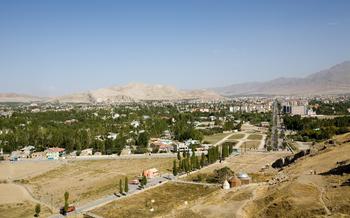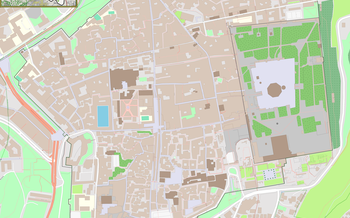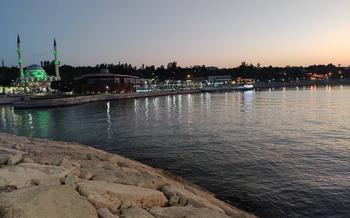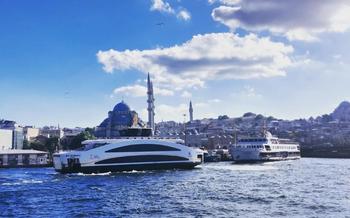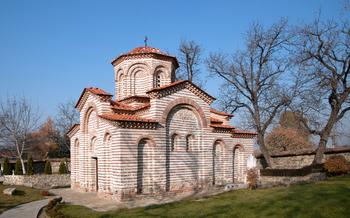
Laleş Church and Monastery
- History and Significance of the Site
- Architectural Marvels: Unveiling the Monastery's Design
- A Place of Worship and Pilgrimage: Laleş's Religious Significance
- Cultural Legacy: Preserving Armenian Heritage in Van
- A Haven of Peace and Tranquility: Experiencing the Monastery's Atmosphere
- Guided Tours: Unveiling the Monastery's Secrets
- Respectful Etiquette: Guidelines for Visitors
- Transportation: Getting to the Monastery
History and Significance of the Site
Nestled amidst the serene landscapes of Van, Turkey, lies the ancient Laleş Church and Monastery, a testament to the rich religious and cultural heritage of the region. Standing as a symbol of Armenian Christianity, the monastery holds profound significance for the Armenian community worldwide. Its origins can be traced back to the 10th century, when it was founded by Saint Gregory of Narek, a renowned Armenian theologian and poet. Throughout the centuries, Laleş Monastery has served as a spiritual center, a place of pilgrimage, and a repository of Armenian culture and traditions. The intricate architecture, exquisite frescoes, and sacred relics within its walls narrate the story of a resilient community that has preserved its identity and faith amidst historical turmoil.
Architectural Marvels: Unveiling the Monastery's Design
The Laleş Church and Monastery showcase the distinctive features of Armenian architecture, a blend of Byzantine and local influences. The church, the heart of the complex, boasts a cruciform plan with a central dome supported by four massive pillars. Its exterior is adorned with intricate carvings and reliefs depicting biblical scenes and Armenian symbols. The interior is equally impressive, with stunning frescoes and paintings covering the walls and ceiling.
Adjacent to the church is a chapel, a smaller structure with a single nave and a semi-circular apse. The chapel's design is simpler, yet it retains the same level of artistry and craftsmanship. The monastery also includes several other structures, such as a bell tower, a library, and a refectory, all built in the same architectural style.
The symbolism and iconography found throughout the monastery are particularly noteworthy. The carvings and frescoes depict various saints, biblical figures, and scenes from the life of Christ. These artistic elements serve as a visual narrative, conveying the religious and cultural significance of the site.
The Laleş Church and Monastery stand as a testament to the architectural prowess and artistic achievements of the Armenian people. Their unique design and rich symbolism make them a must-visit destination for anyone interested in Armenian heritage and architecture.
A Place of Worship and Pilgrimage: Laleş's Religious Significance
For Armenian Christians, the Laleş Church and Monastery holds immense religious significance, serving as a sacred pilgrimage site. Believers from near and far flock to this holy place to pay homage, seek spiritual guidance, and experience the divine presence.
Throughout the year, the monastery hosts a variety of religious rituals, ceremonies, and festivals that draw thousands of pilgrims. These events showcase the rich traditions and customs of the Armenian Christian faith, creating a vibrant and spiritual atmosphere.
One of the most important festivals is the annual pilgrimage to the monastery, which takes place during the summer months. During this time, the monastery becomes a hive of activity, with pilgrims engaging in prayers, candle-lighting ceremonies, and processions. The air fills with the sound of hymns, prayers, and the rhythmic beating of drums, creating a deeply moving and awe-inspiring experience.
Stories of devotion and miracles abound at the Laleş Church and Monastery. Many pilgrims believe that the site possesses miraculous powers, and they come here to seek healing, guidance, and blessings. There are numerous accounts of people who have experienced miraculous recoveries from illnesses, found solace in times of trouble, and received divine interventions after visiting the monastery.
The Laleş Church and Monastery stands as a testament to the deep faith and devotion of the Armenian Christian community. It is a place where people come to connect with their spirituality, seek guidance, and find solace. The monastery's religious significance transcends cultural and geographical boundaries, attracting pilgrims from all corners of the world who seek a deeper connection with their faith.
Cultural Legacy: Preserving Armenian Heritage in Van
The Laleş Church and Monastery holds immense significance as a symbol of Armenian cultural heritage in Van. Throughout history, it has served as a sanctuary for Armenian Christians, providing a space for religious worship, cultural expression, and community gatherings. The monastery has played a crucial role in preserving Armenian traditions, language, and art, showcasing the rich cultural legacy of the Armenian people.
Efforts to restore and maintain the monastery's heritage are ongoing, with various organizations and individuals dedicating themselves to its preservation. These efforts include restoration projects, documentation of historical artifacts, and initiatives to promote cultural understanding and appreciation. The monastery serves as a living testament to the resilience and determination of the Armenian community in Van, showcasing their commitment to preserving their cultural identity.
However, the preservation of the monastery's legacy faces challenges, including the effects of time, natural disasters, and political instability. Despite these challenges, the Armenian community remains dedicated to protecting and promoting their cultural heritage, ensuring that the Laleş Church and Monastery continues to stand as a symbol of Armenian identity and resilience.
A Haven of Peace and Tranquility: Experiencing the Monastery's Atmosphere
Stepping into the confines of the Laleş Church and Monastery, visitors are enveloped in an atmosphere of profound peace and tranquility. The air hangs heavy with the weight of centuries, carrying whispers of prayers and devotions that have echoed within these hallowed walls. The serene ambiance invites visitors to shed the burdens of the outside world and embark on a journey of spiritual introspection.
The monastery's architecture, with its simple yet elegant lines, complements the surrounding natural beauty, creating a harmonious blend of nature and faith. The soft hues of the stone, kissed by the warm glow of the sun, evoke a sense of timelessness. Visitors can find solace in the quiet corners of the monastery, seeking refuge from the bustling world outside.
Whether sitting in contemplation beneath the arched ceilings of the church or strolling amidst the peaceful gardens, the monastery offers countless opportunities for meditation and reflection. The gentle breeze carries the sweet fragrance of wildflowers, adding to the overall serenity of the environment. The panoramic views of the surrounding mountains and valleys, stretching out as far as the eye can see, inspire a sense of awe and wonder.
A visit to the Laleş Church and Monastery is not merely a historical or cultural experience; it is an invitation to connect with one's inner self, to find solace and tranquility amidst the hustle and bustle of modern life.
Guided Tours: Unveiling the Monastery's Secrets
Exploring the Laleş Church and Monastery with a knowledgeable guide offers a unique and enriching experience. Guided tours are available in various languages, providing visitors with a comprehensive understanding of the site's history, architecture, and religious significance. Guides can point out intricate details, explain the symbolism behind the artwork, and share fascinating stories and anecdotes associated with the monastery.
One of the highlights of a guided tour is gaining insights into the monastery's role as a spiritual and cultural center throughout history. Guides can provide context about the periods of decline and restoration, the challenges faced by the Armenian community, and the ongoing efforts to preserve and maintain the site's heritage.
By joining a guided tour, visitors can discover the hidden corners and secret passages of the monastery, often inaccessible to those exploring independently. Guides can also recommend the best vantage points for photography, ensuring that visitors capture the monastery's beauty from the most stunning angles.
Whether you're a history buff, an architecture enthusiast, or simply seeking a deeper connection to the Armenian culture, a guided tour of the Laleş Church and Monastery is an invaluable experience that will leave a lasting impression.
Respectful Etiquette: Guidelines for Visitors
When visiting any religious site, it's essential to demonstrate respect for local customs and traditions. At Laleş Church and Monastery, appropriate dress is recommended, covering shoulders and knees. Visitors should also maintain a respectful demeanor, avoiding loud conversations or boisterous behavior that may disrupt the serene atmosphere. Refrain from touching or leaning against religious artifacts or artwork, as they hold deep cultural and spiritual significance.
Photography is permitted, but using a flash is discouraged to avoid damaging delicate frescoes or paintings. When taking pictures, be mindful of other visitors and avoid capturing them unintentionally. Noise levels should be kept to a minimum, respecting the tranquil environment conducive to meditation and contemplation.
Interacting with the local community is a valuable opportunity for cultural exchange. A warm smile and a friendly greeting go a long way in establishing rapport. If you're fortunate enough to engage in conversation, show genuine interest in their stories and experiences. Remember, respectful behavior not only enhances your experience but also contributes to preserving the monastery's sacredness and fostering positive relationships with the local community.
Transportation: Getting to the Monastery
Reaching the Laleş Church and Monastery is a journey that offers scenic vistas and cultural insights. From Van city center, public transportation provides a convenient and affordable option. Regular buses and minibuses depart from the city's main bus station, offering a direct route to the monastery. The journey takes approximately 1 hour and 30 minutes, allowing you to relax and enjoy the passing landscapes.
For those seeking a more flexible travel experience, taxis and rental cars are readily available in Van. Taxis offer door-to-door service and can be negotiated for a reasonable fare. Rental cars provide the freedom to explore the region at your own pace and venture into nearby villages and attractions.
The road conditions leading to the monastery are generally well-maintained, making the drive a pleasant and scenic one. However, it's essential to be mindful of potential traffic during peak tourist seasons or local holidays. Ample parking is available near the monastery, ensuring a hassle-free visit.




